| Home | First Posted: June 30, 2012 Jan 21, 2020 | |
Mythical HorsesInteresting Note - "From earliest times white horses are mythologized with exceptional properties, transcending the normal world by having wings (Pegasus from Greek mythology) or having horns (the unicorn). As part of its legendary dimension, the white horse in myth may be depicted with seven heads (Uchaishravas), or eight feet (Sleipnir), sometimes in groups or singly. There are also white horses who are divinatory, who prophesy or warn of danger. As a rare or distinguished symbol, typically a white horse bears the hero or god figure in ceremonial roles or in triumph over negative forces. Herodotus reported that white horses were held as sacred animals in the Achaemenid court of Xerxes the Great (ruled 486-465 BC). while in other traditions the reverse happens when it was sacrificed to the gods. In more than one tradition, the white horse carries patron saints or the world saviour in the end times (Islam and Hinduism), is associated with the sun or sun chariot (Ossetia) or bursts into existence in a fantastic way, emerging from the sea or a lightning bolt. Though some mythologies are stories from earliest beliefs, other tales, though visionary or metaphorical, are found in liturgical sources as part of preserved, on-going traditions."  The Unicorn Is Penned, Unicorn Tapestries, c. 1495-1505 (The Cloisters, Metropolitan Museum of Art, New York City)
"...A unicorn (from Latin unus 'one' and cornu 'horn') is a mythological creature. Though the modern popular image of the unicorn is sometimes that of a horse differing only in the horn on its forehead, the traditional unicorn also has a billy-goat beard, a lion's tail, and cloven hooves-these distinguish it from a horse. Marianna Mayer has observed (The Unicorn and the Lake), "The unicorn is the only fabulous beast that does not seem to have been conceived out of human fears. In even the earliest references he is fierce yet good, selfless yet solitary, but always mysteriously beautiful. He could be captured only by unfair means, and his single horn was said to neutralize poison." In heraldry, a unicorn is depicted as a horse with a goat's cloven hooves and beard, a lion's tail, and a slender, spiral horn on its forehead. Whether because it was an emblem of the Incarnation or of the fearsome animal passions of raw nature, the unicorn was not widely used in early heraldry, but became popular from the 15th century. Though sometimes shown collared, which may perhaps be taken in some cases as an indication that it has been tamed or tempered, it is more usually shown collared with a broken chain attached, showing that it has broken free from its bondage and cannot be taken again. It is probably best known from the royal coat of arms of Scotland and the United Kingdom: two unicorns support the Scottish arms; a lion and a unicorn support the UK arms. The arms of the Worshipful Society of Apothecaries in London has two golden unicorn supporters (although, as emblazoned on its homepage, they have horses', not lions', tails)..." 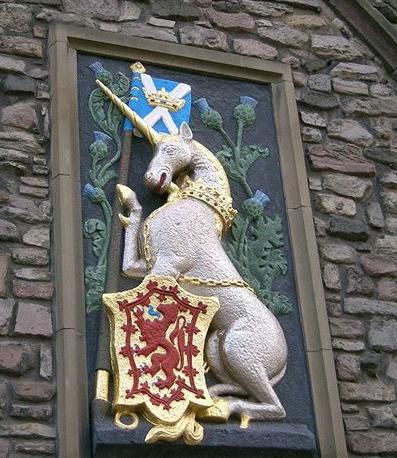 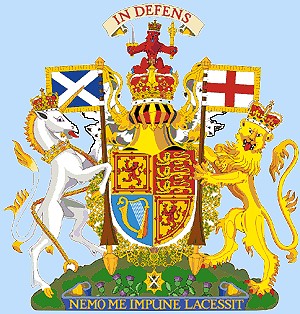 Scotland Coat of Arms
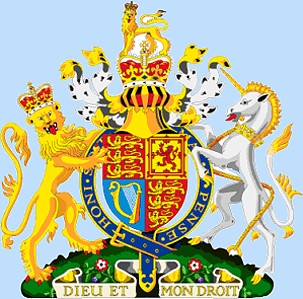 United Kingdom Coat of Arms
  Bellerophon riding Pegasus
In Greek mythology, Pegasus was a winged horse sired by Poseidon, in his role as horse-god, and foaled by the Gorgon Medusa. He was the brother of Chrysaor, born at a single birthing. By extension, the term Pegasus (and the plural Pegasi) can also refer to any winged horse. The Pegasus was cared for by one of Poseidons many daughters, Clarissa. EtymologyThe poet Hesiod connects the name Pegasus with the word for "spring, well," pege: "the pegai of Okeanos, where he was born;" however, the name's origins may come from the word in the Luwian language: pihassas, meaning "lightning." Pegasus and SpringsEverywhere the winged horse struck his hoof to the earth, an inspiring spring burst forth. One of these springs was upon the Muses' Mount Helicon, the Hippocrene ("horse spring"), opened, Antoninus Liberalis suggested, at the behest of Poseidon to prevent the mountain swelling with rapture at the song of the Muses; another was at Troezen. Hesiod relates how Pegasus was peacefully drinking from a spring when the hero Bellerophon captured him. Hesiod also says Pegasus carried thunderbolts for Zeus. There are several versions of the birth of the winged stallion and his brother Chrysaor in the far distant place at the edge of Earth, Hesiod's "springs of Oceanus, which encircles the inhabited earth, where Perseus found Medusa: One is that they sprang from the blood issuing from Medusa's neck as Perseus was beheading her, similar to the manner in which Athena was born from the head of Zeus. In another version, when Perseus beheaded Medusa, they were born of the Earth, fed by the Gorgon's blood. A variation of this story holds that they were formed from the mingling of Medusa's blood and sea foam, implying that Poseidon had involvement in their making. The last version bears resemblance to the birth of Aphrodite. Chinese Year of the Horse/ZodiacThe Horse is the seventh of the 12 animals which appear in the Chinese zodiac related to the Chinese calendar. The Year of the Horse is associated with the earthly branch. Years and the Five ElementsPersons born within these date ranges can be said to have been born in the "year of the Horse," while also bearing the following elemental sign: 25 January 1906 - 12 February 1907: Fire Horse 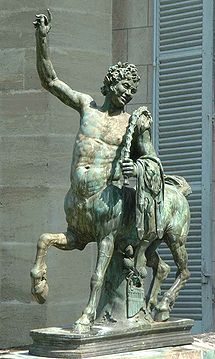 In Greek mythology, the centaurs are a race of creatures composed of part human and part horse. In early Attic vase-paintings, they are depicted as the torso of a human joined at the (human's) waist to the horse's withers, where the horse's neck would be. This half-human and half-animal composition has led many writers to treat them as liminal beings, caught between the two natures, embodied in contrasted myths, and as the embodiment of untamed nature, as in their battle with the Lapiths, or conversely as teachers, like Chiron. The centaurs were usually said to have been born of Ixion and Nephele (the cloud made in the image of Hera). Another version, however, makes them children of a certain Centaurus, who mated with the Magnesian mares. This Centaurus was either the son of Ixion and Nephele (instead of the Centaurs) or of Apollo and Stilbe, daughter of the river god Peneus. In the latter version of the story his twin brother was Lapithus, ancestor of the Lapiths, thus making the two warring peoples cousins Centaurs were said to have inhabited the region of Magnesia and Mount Pelion in Thessaly, Mount Pholoe in Arcadia and the Malean peninsula in southern Laconia.
 A relief of Epona, flanked by two pairs of horses, from Roman Macedonia.
One of the only Celtic deity to have a place in the Roman pantheon. Passion: Strength and Beauty Epona is especially significant to young women. Epona, 3rd c. AD, from Freyming (Moselle), France (Musée Lorrain, Nancy)In Gallo-Roman religion, Epona was a protector of horses, donkeys, and mules. She was particularly a goddess of fertility, as shown by her attributes of a patera, cornucopia, ears of grain and the presence of foals in some sculptures (Reinach, 1895). H. Hubert suggested that the goddess and her horses were leaders of the soul in the after-life ride, with parallels in Rhiannon of the Mabinogion. Unusually for a Celtic deity, most of whom were associated with specific localities, the worship of Epona, "the sole Celtic divinity ultimately worshipped in Rome itself," was widespread in the Roman Empire between the first and third centuries CE. EtymologyAlthough known only from Roman contexts, the name Epona, 'Great Mare' is from the Gaulish language; it is derived from the inferred proto-Celtic *ekwos 'horse' - which gives rise to modern Welsh ebol 'foal' - together with the augmentative suffix - on frequently, though not exclusively, found in theonyms (for example Sirona, Matrona, and the usual Gaulish feminine singular - a. In an episode preserved in a remark of Pausanias, an archaic Demeter too had also been a Great Mare, who was mounted by Poseidon in the form of a stallion and foaled Arion and the Daughter who was unnamed outside the Arcadian mysteries. Demeter was venerated as a mare in Lycosoura in Arcadia into historical times. Evidence for EponaFernand Benoit found the earliest attestations of a cult of Epona in the Danubian provinces and asserted that she had been introduced in the limes of Gaul by horsemen from the east. This suggestion has not been generally taken up. Although the name is in origin Gaulish, dedicatory inscriptions to Epona are in Latin or, rarely, Greek. They were made not only by Celts, but also by Germans, Romans and other inhabitants of the Roman Empire. An inscription to Epona from Mainz, Germany, identifies the dedicator as Syrian. A long Latin inscription of the first century BCE, engraved in a lead sheet and accompanying the sacrifice of a filly and the votive gift of a cauldron, was found in 1887 at Rom, Deux-Sévres, the Roman Rauranum. The inscription offers to the goddess an archaic profusion of epithets for a goddess, Eponina 'dear little Epona:' she is Atanta, horse-goddess Potia 'powerful Mistress' (compare Greek Potnia), Dibonia (Latin, the 'good goddess'), Catona 'of battle,' noble and good Vovesia. Her feast day in the Roman calendar was December 18 as shown by a rustic calendar from Guidizzolo, Italy, although this may have been only a local celebration. She was incorporated into the Imperial cult by being invoked on behalf of the Emperor, as Epona Augusta or Epona Regina. The supposed autonomy of Celtic civilization in Gaul suffered a further setback with Fernand Benoit's study of the funereal symbolism of the horseman with the serpent-tailed ("anguiforme") daemon, which he established as a theme of victory over death, and Epona; both he found to be late manifestations of Mediterranean-influenced symbolism, which had reached Gaul through contacts with Etruria and Magna Graecia. Benoit compared the rider with most of the riders imaged around the Mediterranean shores. Perceptions of native Celtic goddesses had changed under Roman hegemony: only the names remained the same. As Gaul was Romanized under the early Empire, Epona's sovereign role evolved into a protector of cavalry. The cult of Epona was spread over much of the Roman Empire by the auxiliary cavalry, alae, especially the Imperial Horse Guard or equites singulares augustii recruited from Gaul, Lower Germany, and Pannonia. A series of their dedications to Epona and other Celtic, Roman and German deities was found in Rome, at the Lateran. As Epane she is attested in Cantabria, northern Spain, on Mount Bernorio, Palencia. A bizarre euhemeristic account of the birth of Epona that does not reflect Celtic beliefs can be found in Plutarch's life of Solon: Giambattista Della Porta's edition of Magia naturalis (1589), a potpourri of the sensible and questionable, remarks, in the context of unseemly man-beast coupling, Plutarch's Life of Solon, in which he "reports out of Agesilaus, his third book of Italian matters, that Fulvius Stella loathing the company of a woman, coupled himself with a mare, of whom he begot a very beautiful maiden-child, and she was called by a fit name, Epona..." IconographySculptures of Epona fall into five types, as distinguished by Benoit: riding, standing or seated before a horse, standing or seated between two horses, a tamer of horses in the manner of potnia theron and the symbolic mare and foal. In the Equestrian type, common in Gaul, she is depicted sitting side-saddle on a horse or (rarely) lying on one; in the Imperial type (more common outside Gaul) she sits on a throne flanked by two or more horses or foals. In distant Dacia, she is represented on a stela (now at the Szépmüvézeti Museum, Budapest) in the format of Cybele, seated frontally on a throne with her hands on the necks of her paired animals: her horses are substitutions for Cybele's lions. In Roman Texts and InscriptionsEpona is mentioned in The Golden Ass by Apuleius, where an aedicular niche with her image on a pillar in a stable has been garlanded with freshly-picked roses. In his Satires, the Roman poet Juvenal also links the worship and iconography of Epona to the area of a stable. Small images of Epona have been found in Roman sites of stables and barns over a wide territory. In the British IslesThe probable date of ca. 1400 BCE ascribed to the giant chalk horse carved into the hillside turf at Uffington, in southern England, is too early to be directly associated with Epona a millennium and more later, but clearly represents a Bronze Age totem of some kind. The English traditional hobby-horse riders parading on May Day at Padstow, Cornwall and Minehead, Somerset, which survived to the mid-twentieth century, even though Morris dances had been forgotten, may have deep roots in the veneration of Epona, as may the English aversion to eating horsemeat. At Padstow formerly, at the end of the festivities the hobby-horse was ritually submerged in the sea. A provincial though not crude small (7.5 cm high) Roman bronze of a seated Epona, flanked by a small mare and stallion, found in England, is conserved in the British Museum. Lying on her lap and on the patera raised in her right hand are disproportionately large ears of grain; ears of grain also protrude from the mouths of the ponies, whose heads are turned towards the goddess. On her left arm she holds a yoke, which curves up above her shoulder, an attribute unique to this bronze statuette. The Welsh goddess Rhiannon rides a white horse and has many attributes of Epona. A south Welsh folk ritual call Mari Lwyd (Grey Mare) is still undertaken in December - an apparent survival of the veneration of the goddess. The pantomime horse is thought to be a related survival. Celtic and Roman; the Horned God of the Hunt Passion: the HuntCernunnos is a Roman name meaning "horned one." His Celtic name is unknown, although he may be associated with Derg Corra, the early Celtic "Man in the Tree." He is the mysterious horned deity worshipped by Iron age Celts across Europe until the end of the first century. Very little is known about Cernunnos except his name and his image. To the Celts as Cernunnos, the Horned God was more than just a fertile being. He is found throughout the Celtic lands and folklore as the guardian of the portal leading to the Otherworld. The name Cernunnos is known only through damaged carvings found at Notre Dame. In these carvings, a deity with short horns carries the incomplete inscription 'ERNUNNO.' He was such an important deity to the pagan Celts, that his image and prowess became a major target for the early Christian church. It is his image that is believed to have been adopted for their mythos of the Devil 'deo falsus' or the false god. His status as the god of Hell would coincide with the view of the pagan Celts as the guardian of the Otherworld. 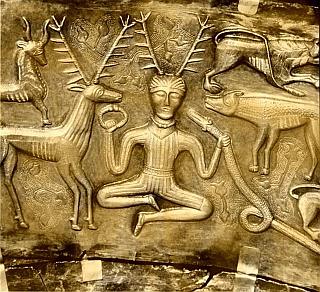 Cernunnos
Abraxas (Roman) One of Aurora's horses. Balius or Balios (Greek) Achilles' horse, and brother of Achilles' other horse, Xanthus (Xanthos) Xanthus (Xanthos)(Greek) Achilles' horse, and brother of Achilles' other horse, Balios. They were the offspring of Zephyrus and Podarge (Podarge, one of the Harpies or Podarge, one of Hector's horses). This superb matched pair of horses are immortal and endowed with human speech. Xanthus prophesied Achilles' death and Achilles answered, in effect, "Yes, I know, I know; you don't have to tell me!" 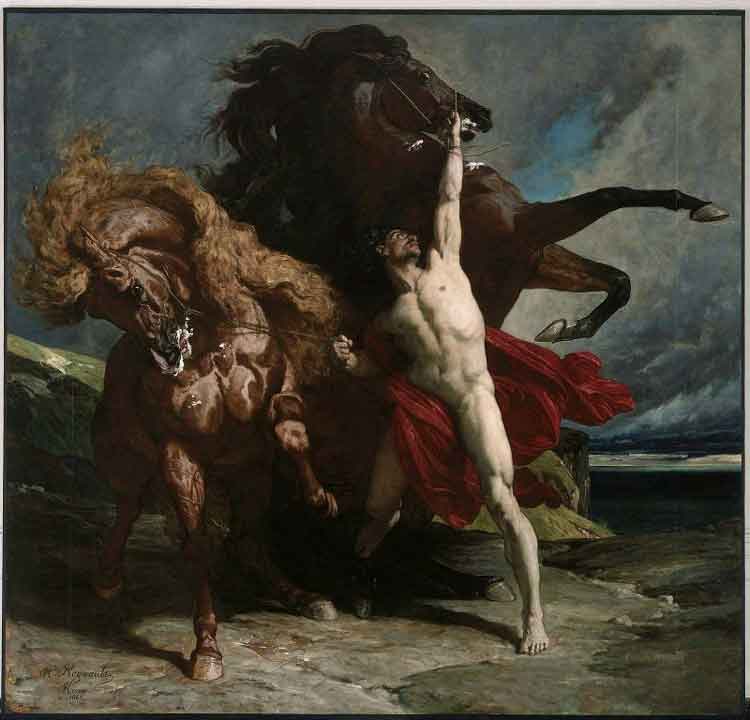 Balius and Xanthus
Automedon and the Horses of Achilles, Henri Alexandre Georges Regnault, 1868
Balius and Xanthus were the horses of Achilles in the Trojan War. They are children of Podarge a Harpy. Hippocampus (Roman) The hippocampus is a creature that is half-horse and half-fish, with the head and forequarters of a horse and the tail and hindquarters of a dolphin. It had forelegs with webbed paws, and may have a fin on the back of its neck. Neptune's chariot was pulled through the ancient seas by several of these creatures, and Neptune was occasionally seen riding one. 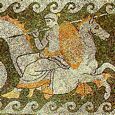 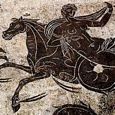 In Norse mythology, Sleipnir (Old Norse "slippy" or "the slipper" is an eight-legged horse. Sleipnir is attested in the Poetic Edda, compiled in the 13th century from earlier traditional sources, and the Prose Edda, written in the 13th century by Snorri Sturluson. In both sources, Sleipnir is Odin's steed,(Sleipnir could travel through the air and over the sea, and was swift enough to beat any other horse in a race) is the child of Loki (disguised as a mare in that event) and Svaôilfari, (the horse that helped build the walls of Asgard) is described as the best of all horses, and is sometimes ridden to the location of Hel. The Prose Edda contains extended information regarding the circumstances of Sleipnir's birth, and details that he is gray in color. 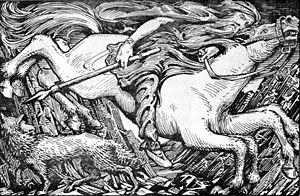 "Odin Rides to Hel" (1908) by W. G. Collingwood.
|